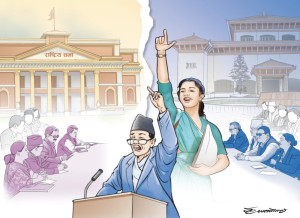Columns
E-cooking for sustainability
A robust makeover of the electricity distribution system can promote its active use at the household level.
Basudev Upadhyay
Electricity as a clean, affordable and eco-friendly energy source is vital in Nepal. This is because indoor air pollution caused by contaminating fuels—used by 50 percent of Nepal’s population—leads to about 24,000 deaths yearly. Using electrical energy instead of inefficient wood and fossil fuels significantly curbs health risks such as chronic obstructive pulmonary disease (COPD), acute respiratory infection (ARI), lung cancer and even death. The second-most used cooking fuel is liquefied petroleum gas, but high foreign currency reserves are being invested in its imports. Switching to e-cooking can be a much-needed boost to expand the current underwhelming domestic electricity consumption and transition towards cleaner and more productive energy use.
Last year, the Government of Nepal reported an over 30 percent surge in e-cooktop imports compared to the preceding year. From an economic perspective, a shift towards environment-friendly cooking is a well-timed alternative for reducing trade deficits from LPG gas imports. The foreign currency reserves thus saved could be channelled towards more productive sectors contributing to national development.
One essential convener to e-cooking demands can be attributed to the government’s strategies to ensure energy access and equip each household with clean cooking devices by 2030 through national and international goals and commitments. These include the 15th five-year plan, the second Nationally Determined Contribution submitted to the United Nations Framework Convention on Climate Change (UNFCCC), the Sustainable Development Goals (SDG) 2030, and the Sustainable Energy for All (SE4All). This is to achieve NetZero goals supported by I/NGOs, the private sector, civil society groups and others.
But there is still a long way to go. The 15th Five-Year Plan endorsed by the Government of Nepal expected 100 percent of the Nepali population to have access to electricity by 2023-24. In 2021, we reached almost 92 percent, but even today, only 0.5 percent use electricity as a primary cooking fuel.
A smooth and uninterrupted electricity supply is key to sustaining this momentum and encouraging a wider uptake of electric stoves nationwide. The urban population, with better purchasing capacities, benefits as early adopters, while for the rural population, affordability is a constraint in addition to irregular supply and unreliable electricity distribution systems. The next group of adopters with the most potential (the early majority) resides in the semi-urban areas that require sensitisation through behavioural change and communication in addition to regular electricity supply and upgraded distribution systems. An innovative market-led approach that sufficiently addresses the awareness, access, affordability and investment issues can accelerate adoption among early and late majority groups.
Some considerations need to be taken in the 16th Five-Year Plan. Availability of standard e-cooktops, along with efficient electricity distribution systems, revised e-tariffs, incentives and e-cooking promotional programmes, can help leapfrog towards achieving SDG 7: Universal access to clean and affordable energy with NetZero targets.
Currently, distribution systems managed by the National Electricity Authority (NEA) and the Community Rural Electrification Entities (CREEs) do not meet compliance standards, especially in remote areas. A robust makeover of the electricity distribution system is necessary to increase the number of e-cooking adopters and promote sustained use at the household level. Local government, NEA subsidiary, and CREE must work together to support e-cooking adoption at the local level by speeding up the system upgrade provisioned by Community Electrification bylaws.
The existing progressive e-tariff is a menace to the sustained use of e-cooking devices: The free minimum consumption for lower-end users/consumers usually demotivates continuous use beyond the free limit of 20 units for rural customers. Reconsideration of e-tariffs that motivate the use of essential gadgets such as e-cooking devices is necessary if we hope to target peripheral consumers.
Governments at all levels should consider a holistic approach while designing and implementing electric cooking promotional programmes in close coordination with related stakeholders and vice versa. Therefore, complementing each other’s work and minimising duplication must be prioritised. Authorities should ensure an enabling environment with necessary policies and pragmatic guidelines to support the e-cooking transition—for instance, tax exemption of e-cooking appliances, promotion of local manufacturing of e-cooking devices, etc.
The systematic implementation of incentive provisions is essential in promoting a sustainable market for e-cooking. Failing to achieve uniformity and random selection of incentive recipients would only create situations where the real, needful population don’t receive them. Incentives and subsidies must be planned to ensure a participatory market system development of e-cooking products. Need-based incentivisation is essential to ensure the subsidies reach the needy category of the population.
Developing and contextualising standards and regulating them for effective implementation can foster confidence in transitioning to e-cooking. This can support the circular economy by importing only standardised products. Moreover, cooking fuel and technology choices depend on accessibility, demographic, and socio-economic factors. Promoting manufacturing within the country can further ensure the cost-effectiveness of the transition.
Creating awareness about the cost-effectiveness and safety protocols while using e-cooktops, ensuring after-sales services, and swiftly responding to related queries are necessary interventions to propagate e-cooking adopters and ensure sustained use. This is most effective when the target community participates in the process.
While the majority of the population in the country is still dependent on traditional inefficient biomass, switching to cleaner fuels like electricity can form a basis for attaining sustainable development. The conducive environments created by our commitments through SDG7 and our country-specific report NDC II to UNFCCC in attaining NetZero goals have been instrumental so far. Now, we need to strengthen our two major enablers- the adequate and reliable electricity supply and well-functioning e-cooking appliance supply systems to pave the path towards transition to e-cooking in Nepal.




 16.24°C Kathmandu
16.24°C Kathmandu















